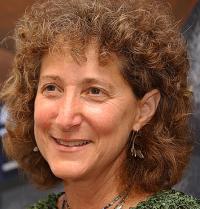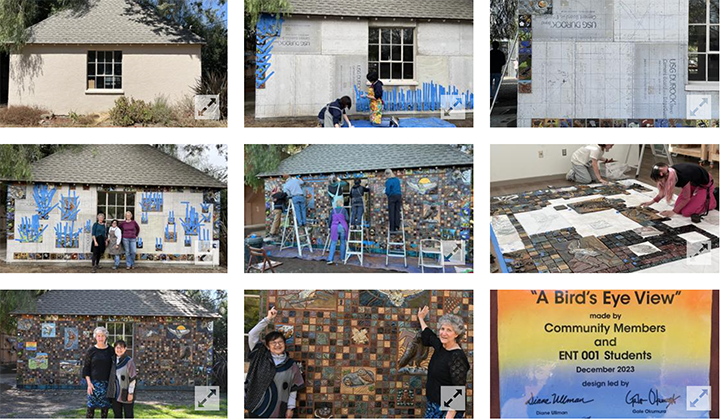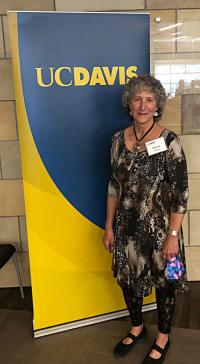
UC Davis Distinguished Professor Diane Ullman: 'World-Class'
Urban Landscape Entomologist Emily Meineke Pays Tribute to World-Class Teacher, Researcher, Artist

UC Davis Distinguished Professor Diane Ullman, a 29-year member of the Department of Entomology and Nematology faculty, drew accolades and applause at the department's retirement event on June 11 at the UC Davis Alumni Center.
"Everything she does is world class," urban landscape entomologist and assistant professor Emily Meineke told the crowd.
Meineke, who began co-teaching with Ullman in the popular class, Entomology (ENT) 001, "Art, Science and the World of Insects" in the spring of 2022, opened her tribute by recalling a visit to the campus by George Kennedy, the William Neal Reynolds Distinguished Professor of Agriculture, Department of Entomology and Nematology, North Carolina State University and a past president (1988) of the Entomological Society of America (ESA). Kennedy and Ullman are longtime friends and research collaborators (insect-plant interactions), and both are ESA Fellows: Kennedy in 2003, and Ullman in 2011.
"A few years ago, Diane’s colleague George Kennedy visited her here at UC Davis," Meineke began. "To me, George Kennedy is a giant. He was department head at NC State when I was getting my PhD, and when he came to visit Diane, he and I met up in my office. I remember him being so excited that I was being mentored by Diane so early in my career here. He’s a person of few words and so the words he says hit hard. And I’ll never forget what he said about Diane in that meeting. I can quote it verbatim:
"Everything she does is world class."
"In the past decades of her career, Diane has made countless discoveries about plant pathogens that have enriched our basic understandings and, importantly, precipitated real benefits for farmers and food production. There’s no doubt about that."
"But the context in which I know Diane and have seen her brilliance is in her teaching. For the past few years, we’ve taught ENT 001 together with the understanding that I will continue it after she retires. I will try (and fail) to explain how Diane has both prepared me for this and left infinitely big shoes to fill."
"In addition to serving as a scientist and an educator, Diane is a community-based artist. This is not a title she throws around so I’m gonna do it for her. In ENT 001, instead of a traditional lab, she has built a course wherein students create art and, in the process, learn about insects, including about their morphology, physiology, and ecology."
Meinke explained that "Students are assigned an insect, made to do extensive research on that insect and then design and build a piece of art. Most years, students build their insects from clay, and often, those clay pieces are integrated into public art pieces."

"Maybe you all know this. But what most of you don’t know is that Diane has also created a world. In the corner of the arboretum, in a basically abandoned building that no one wants, an entire community of volunteers, TAs (teaching assistants), and their visitors go about daily life, in a microcosm of what I think many of us wish the world were like. Diane has attracted people who exude kindness, people who put community first, and people who work exceptionally hard to make sure students know that they are cared about."
"In that space, Diane is our undisputed queen bee. She’s the one who knows where everything is, how not to burn the building down, and whose birthday is coming up. She has a way of entering a room with an anecdote about her dogs, or her husband Jean Marc and how very French he is, or her garden, and somehow the anecdote always makes all of us want to stop what we’re doing and listen."
"Over the years, Diane has created countless pieces with students that will live beyond all of us. They are installed in the Arboretum, the Raptor Center, Matthiasson Winery, Bee Biology, among many other places. The Arboretum was my favorite place when I moved here because of her pieces at the entrance and in the oak grove that orient visitors. That is how big Diane’s impact is. It precedes her."

"But I think Diane’s most colossal accomplishments are related to the impressions she makes on students. I’ve run into countless entomologists who have joined our ranks because of ENT 001. Students visit the art pieces they make with Diane with their parents, and I’ve seen the pride on their faces."
"In the art studio, maybe the thing that has had the biggest impression on me is how often I hear Diane ask students: How do you want your piece to look? The students often look back at her with this puzzled and sometimes panicked look, because they are so rarely asked by anyone in charge what they want."
"And that’s the magic of Diane. Which is to say, not magic at all. In everything she does, she puts people first, and we have all been better for having been in her sphere. Luckily for us, Diane will continue as the queen, the empress of the Labudio (a combination of a science laboratory and an art studio). But now she’ll only do her favorite parts of her job. And whatever she chooses to continue doing, I’m sure it’ll be world class.
"Thank you for everything, Diane," Meineke concluded, "and congratulations."
Ullman, who holds a bachelor's degree in horticulture from the University of Arizona, received her doctorate in entomology from UC Davis in 1985. She served on the faculty of the University of Hawaii's Department of Entomology from 1987 to 1995, and then joined the UC Davis faculty as a professor in 1995. She chaired the Department of Entomology in 2004-05, and served as associate dean for Undergraduate Academic Programs, College of Agricultural and Environmental Sciences from 2005-2014.
Ullman co-founded (2006) and directs the UC Davis Art/Science Fusion Program.
In her remarks to the crowd at the retirement event, Ullman noted that "I came her as a graduate student, and I took Jim Carey's insect ecology class."

She praised the "strong, diverse, robust place that our department has become" and expressed her thanks that the epartment allowed her to puruse science and art. "This is the best career I could have possibly imagined."
Ullman focuses her research on insects that transmit plant pathogens, in particular plant viruses. "She is best known for advancing international knowledge of interactions between thrips and tospoviruses and aphids and citrus tristeza virus," according to the ESA's biographical post.
She noted her collaborative work and appointment on the graduate faculty of the Department of Plant Pathology. "That department welcomed my interdisciplinary work and was extremely supportive of me," she said. "I had several wonderful graduate students from that program and co-taught Plant-Virus-Insect Interactions (ENT 123) with Bob Gilbertson for nearly three decades."
A Fellow of both the American Association for the Advancement of Science (2014) and the Entomological Society of America (2011), Ullman was named the 2014 recipient of the ESA National Excellence in Teaching Award, and won a 2022 Distinguished Teaching Award for Undergraduate Teaching from the UC Davis Academic Senate.
"I have seen in Diane the rare academic who places co-equal emphasis on her research program, which has given her international acclaim, and her teaching and mentorship," UC Davis distinguished professor Jay Rosenheim wrote in his letter of nomination for the Academic Senate award. "Diane cares for every student who comes into her classes and her laboratory, takes them under her wing, and helps them thrive. She cares deeply about the well-being of everyone she mentors, and it shows in everything she does."
Rosenheim, who also is retiring in June, noted in his letter that her commitment to mentorship motivated her to "create a nationwide mentorship program as part of a $3.75 million grant from the USDA, for which she was the lead principal investigator, to give undergraduate students a closely mentored opportunity to conduct individual research projects. This program (Vector Pathogen Educational Network or VPEN) trained 28 postdoctoral researchers and graduate students to be mentors, and then paired each with an undergraduate student researcher mentee."
Rosenheim praised her entomology class, ENT 001, "Art, Science and the World of Insects," which he described as "a unique and creative course, created by Diane, to bring together art and science. The class includes two hours of lecture each week plus a single three-hour “labudio” – i.e., a combination of a science laboratory and an art studio. The lectures cover the biology and ecology of insects, including their interactions with humans and their importance in human culture."
In a letter of support, undergraduate entomology student Kyle Elshoff, Class of 2024, described Professor Ullman as "one of the best instructors I've ever had. She has a love and passion for both art and science that is infectious and inspires further discussion and exploration by students outside of class."
Professor Ullman is committed to "helping us succeed," Elshoff related, "especially with the challenges presented by remote learning during a pandemic. For instance, despite being unable to work with us in-person to create art in the wonderfully named 'Labudio,' she still ensured that every student would be able to exercise their creativity and create a meaningful final artwork. She prepared and shipped each of us a box of watercolor supplies to use and keep, and she recorded watercolor video tutorials with a local artist so that we could familiarize ourselves with basic principles and techniques. I felt supported by these kind actions; it was reassuring to know that I had a professor who cared about me and who, right from the outset, was willing to go the extra mile for her students."

Elshoff concluded: "My experience in her ENT 001 course last spring was one that lifted my spirits, enriched my education, and strengthened my love for art and science during a time when it was difficult to feel positive about anything. More than just a professor, Dr. Ullman is someone who I feel comfortable reaching out to for advice and guidance as I move forward with entomology and art."
One of Ullman's latest projects, with Gale Okumura and the ENT 001 students and community members, was "A Bird's Eye View," a ceramic-mosaic mural on the visitors' center of the California Raptor Center on Old Davis Road, UC Davis campus. It tells the story of the interdependence of raptors and insects. It measures 22-feet wide and eight-feet in height and is comprised or more than 1300 handmade ceramic relief artworks, tiles and trim pieces.
The project celebrates "11 key raptor species found in California and 84 insect species that are either parasites of these raptors or eaten by them,” Ullman says.
Another recent project, as mentioned by Meineke in her remarks, was the "Secret Life of Vineyards," created by the Ullman-Meineke/Okumura/ENT 001/community team on an outer wall of the Matthiasson Winery on Dry Creek Road, Napa. The 10 x 6-foot mural depicts more than 80 arthropods (insects, spiders and centipedes), several bird species, mammals (bobcat, deer, rabbits, squirrels, a pocket gopher), a gopher snake, mycorrhizal fungi and even earthworms.
"This mural is a perfect example, showing how UC Davis and the Napa Valley community joined together to create a work that will inspire generations," UC Davis Chancellor Gary May told the crowd at the art unveiling at the winery. "It's not just the colors and textures that draw you in. There's a fascinating story here about sustainability and environmental stewardship. It's about the connectedness of insects, microbes and humans that are at the heart of Napa wine country--and the world beyond. As you look at the mural, you'll see how the ecosystem in an organic vineyard progresses through the harvest season. The artwork contains more than 80 insects, mammals, several bird species and so many other creatures that contribute to biodiversity and balance in the ecosystem."

In her presentation at the unveiling, Professor Ullman described the project "a testimony to the power of collaboration, community effort, creativity and collective will. This expressive, beautiful and educational artwork celebrates the synergy created when art meets science, and people observe the world around them with fresh eyes, testing their ideas and transforming those ideas into new concepts and new insights, and then share their epiphanies with others through design and art."
Ullman noted that the general education class, "Art, Science and the World of Insects," was founded in 1996. It's been taught ever year since, "attracting students from every major offered on the UC Davis campus," she said.
The course--"taught with the notion that patterns, harmonies, symbols, and perceptions are shared across borders and disciplines--creates accessibility and inclusion for people that would otherwise fear science, or fear art," Ullman told the crowd. "Not only does this paradigm provide a new and innovative classroom learning experience, it creates collaborations between different kinds of students and the community."
The concept of an art/science paradigm "opened the door for students and community members to interpret the scientific endeavors of the campus and science of entomology," said Ullman, praising the College of Agricultural and Environmental Sciences "that supports this innovative method of teaching and extending knowledge to the public."
Resources:
- UC Davis Students Fuse Art and Science to Create Wall Mural at Raptor Center, Department News website, March 18, 2024
Photo Gallery of Bird's Eye View, March 18, 2024 - 'The Secret Life of Vineyards' Mural Is No Longer a Secret,' Department News website, Aug. 29, 2023
